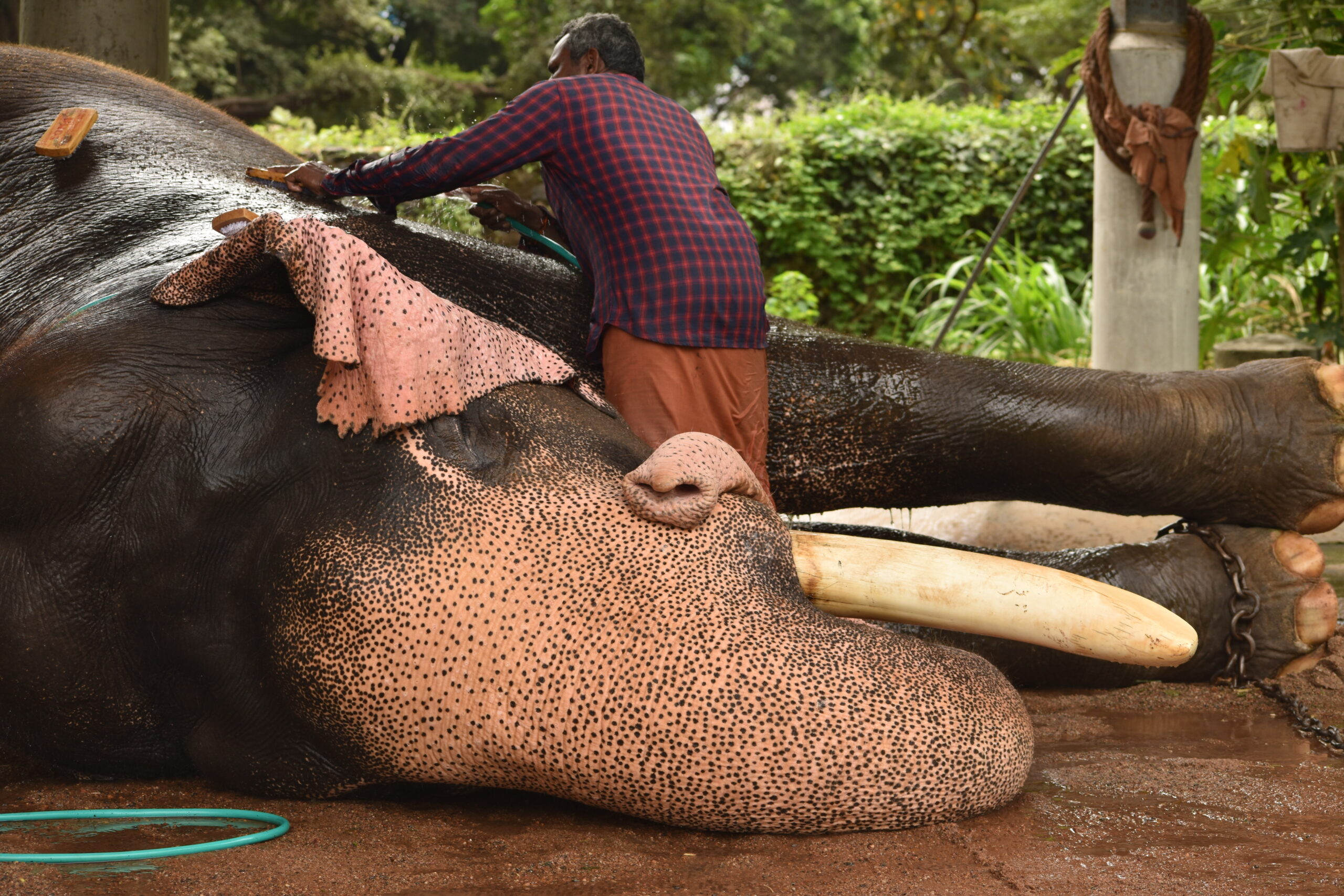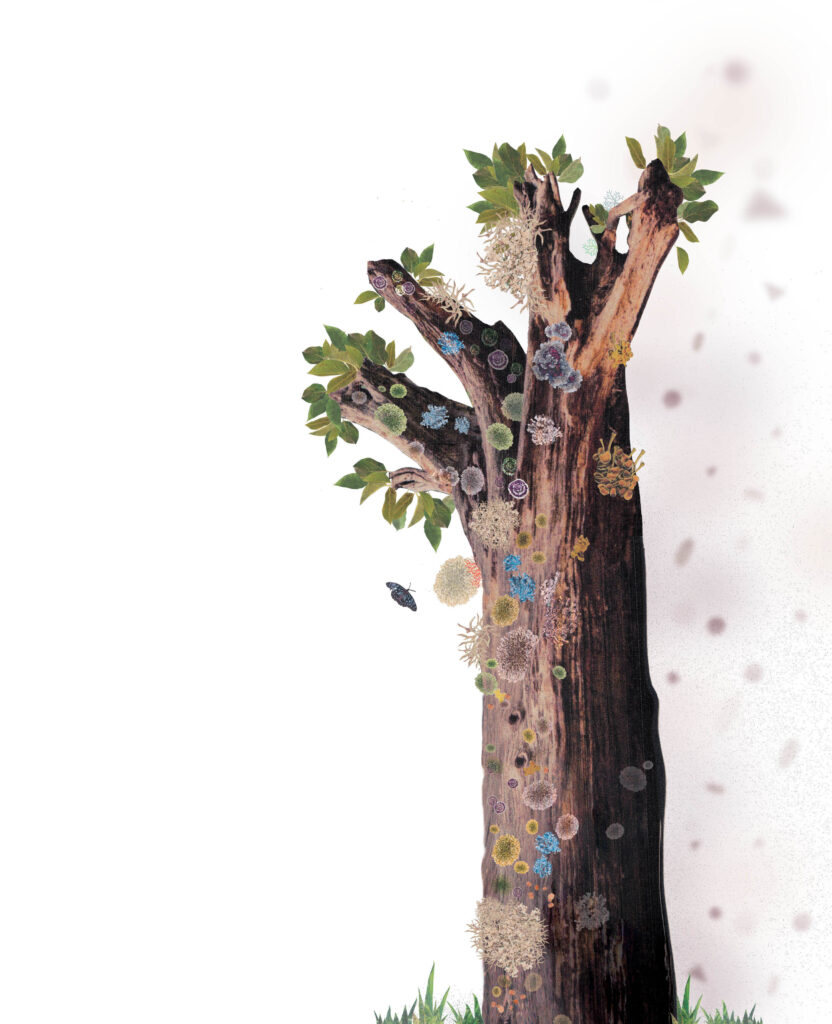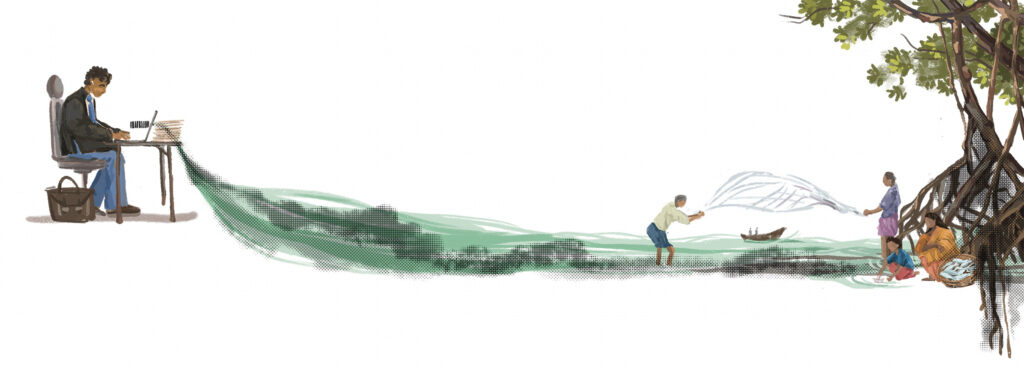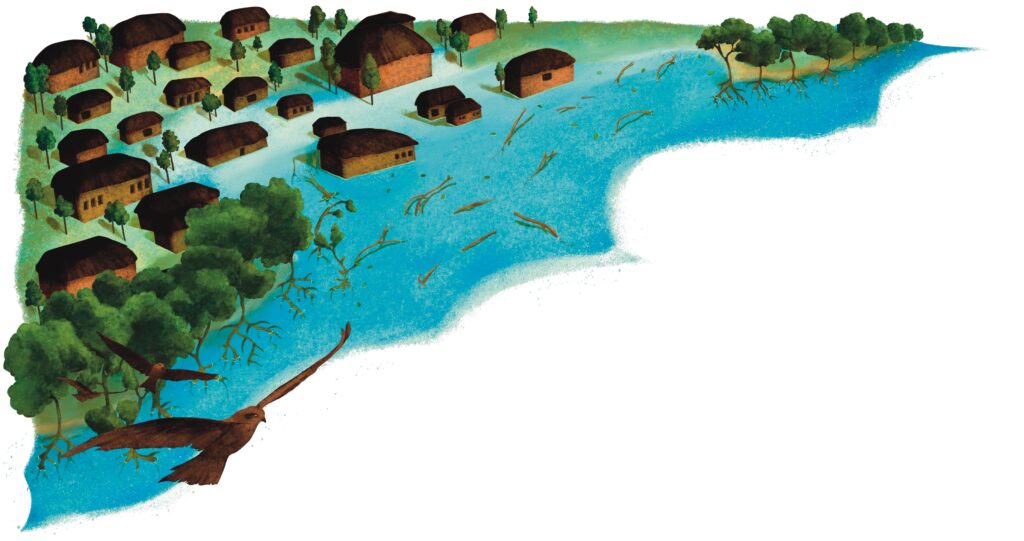Feature image: A captive tusker is being given a scrub bath
“In the olden days, after completing timber work, the elephants were left unfettered in the forest, to forage with a long chain tied to one leg and a bell hanging around their necks, which helped us to track them later. Some elephants would cleverly turn the bell upside down and fill it with soil, preventing it from ringing,” recalls Devasikutty, a 70-year-old retired mahout from the Thrissur district of Kerala, India.
“Sometimes, they would grab the chain with their mouths and walk for kilometres, ensuring that no marks are left behind by the dragging chain. Only a trail of footprints would remain on the ground, making it difficult to locate the individual. We could easily mistake the tracks for those of a wild elephant. Elephants are highly intelligent and use tactics like these to escape work the following day. But they usually returned on their own at the time of feeding kanji (rice porridge).”
Despite bearing scars from an attack by the last elephant he cared for decades ago, Devasikutty speaks without resentment and with only reverence. His words reflect the deep, almost spiritual bond that some mahouts share with these beings. He views elephants as intelligent and emotional, capable of remembering those who have wronged them and punishing them later. For generations, mahouts have been custodians of a largely unrecognised body of traditional ecological knowledge (or TEK), built through years of observation, shared learning, and an intimate understanding of the lives of individual elephants.
The Kerala connection
The domestication of elephants in India can be traced back to ancient rock paintings dated around 6000 BC. The Rig Veda Samhita (circa 1500 BC) contains evidence of elephant domestication, including references to elephants as gifts, richly caparisoned elephants, elephants responding to commands, and even elephant keepers’ villages. By the 6th century BC, the capture and taming of wild elephants had become a sophisticated art.
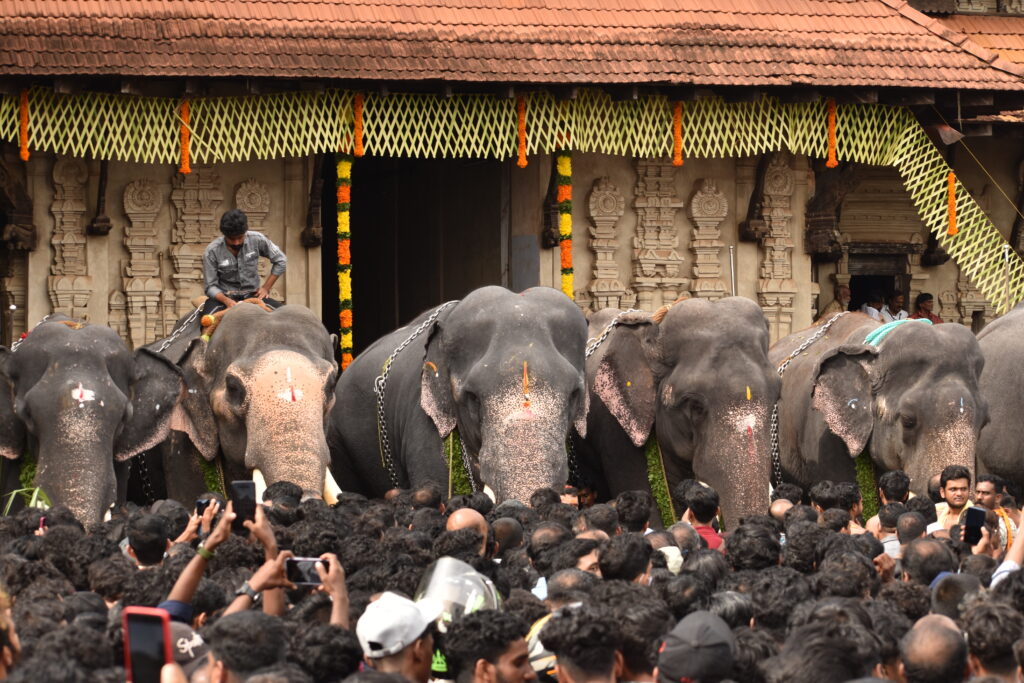
the Sree Vadakkumnathan Temple in Thrissur, Kerala
Indian TEK related to elephant care was well developed long before the same began to take shape in the West. Ancient treatises like the Nakula Saṁhita detailed methods of capture, training, and husbandry, reflecting the role of elephants in warfare and their importance to kings. Among these, the Hastyayurveda (Ayurveda of elephants), attributed to Palakapya, remains one of the most well-known texts on elephant health. Structured as a discourse, it covers a wide range of ailments and treatments and continues to serve as a guide for traditional elephant healers even today.
Elephants have been woven into Kerala’s cultural identity, not only as working animals but as sacred and ceremonial figures. Traditionally owned by big landlords, captive elephants are now privately owned, coinciding with a shift in the primary type of work from timber extraction to use in religious festivals. Beyond the grandeur of decorated elephants surrounded by a sea of people during these ceremonies lies an age-old system of elephant care, deeply rooted in a blend of TEK and Ayurvedic principles. According to Dr. Sankaran, an Ayurveda doctor and second-generation elephant healer based in Thrissur, the dosage of Ayurvedic medicines administered to elephants is traditionally calculated based on principles outlined in Hastyayurveda. “It is generally considered to be 16 times the human dosage or adjusted according to the elephant’s body weight,” he explains.
Ethnoveterinary knowledge is gradually fading, as traditional practices are often perceived as anecdotal or informal when compared to modern veterinary science. However, rather than existing in opposition, these two systems have the potential to complement one another. For instance, the month of Karkidakam (17 July–17 August), which coincides with the monsoon season in Kerala, is traditionally set aside for rest and rejuvenation. After the physically demanding festival season, this period provides elephants with a much-needed break and a time for immunity-boosting treatments. The renowned Guruvayur temple houses around 37 elephants at a camp called Anakkotta (which translates to ‘elephant fort’), where these treatments are supervised by an expert panel of veterinary doctors—including an Ayurveda specialist—ensuring a thoughtful integration of TEK and modern science.
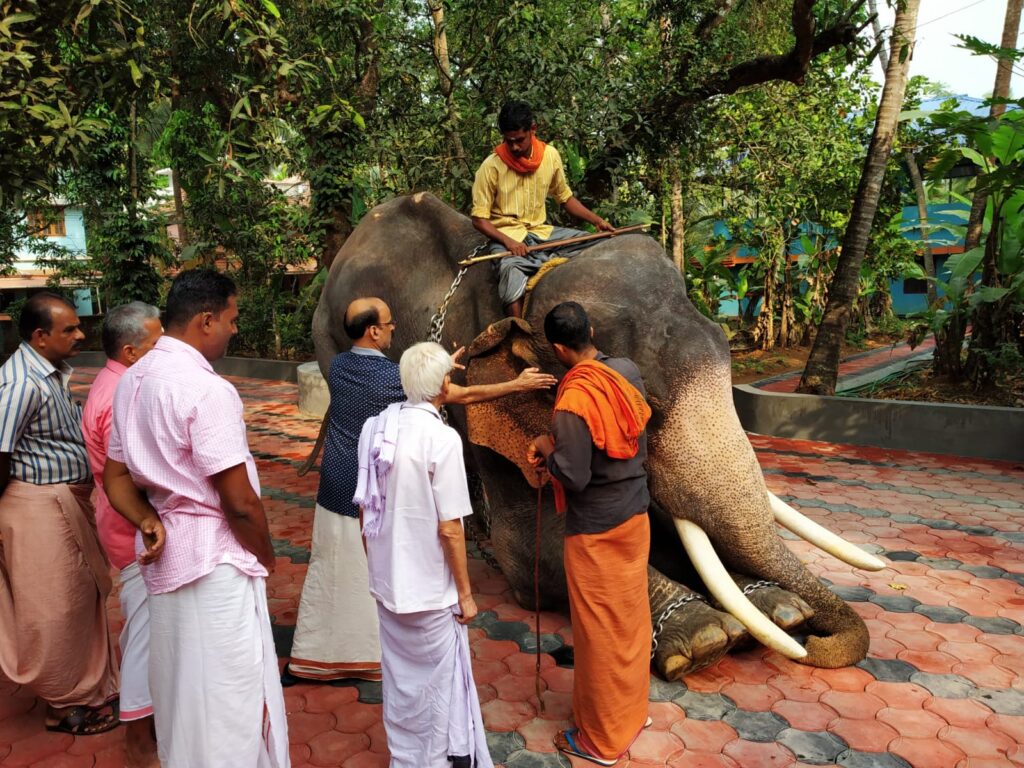
Elephant whisperers
Ramakrishnan is an 80-year-old mahout who began his training at the age of nine. He attributes much of his knowledge to the time he spent with the Malayanmaar (forest-dwelling tribal communities). They taught him how to navigate the forest, tame wild elephants, and use traditional medicines—knowledge that he says was shared only after years of trust and close association. He recalls how close daily interactions enabled him to read subtle signs in an elephant’s behaviour.
In Ramakrishnan’s experience, “If we truly care about the elephant or have the necessary knowledge, we can detect illness by simply observing its drinking habits. For instance, if an elephant drinks half its usual amount of water in the morning, we might assume it’s because it is not thirsty or it ate water-rich foods such as plantain stem, watermelon, or orange. But if it happens a second time, we start getting concerned. After a while, we will try to offer water again. If the elephant still drinks less, we realise that something is wrong. We get to know it by observing changes in its behaviour, much like how we can discern if a close person is feeling sick or is in pain just by looking at their face.”
Reflecting on present day practices, he observes that this kind of intuitive understanding is becoming increasingly rare. In his view, the relationship between mahouts and elephants has grown more transactional over time. In the past, mahouts spent decades with a single elephant, forming lasting bonds; however, many now treat their role as merely a temporary job. Elephants are often reduced to decorative showpieces at festivals, valued more for their spectacle than for their sentience. Without genuine affection or a deep understanding of an elephant’s needs, he argues that the quality of care inevitably suffers.
Mahouts like Ramakrishnan have extensive knowledge of using locally available natural ingredients such as turmeric, coconut oil, ginger, neem leaves, salt, ghee, garlic, the touch-me-not plant, and asafoetida to treat common ailments. These remedies, recognised for their medicinal properties in Ayurveda, have long been passed down orally. But as traditional mahoutship declines and fewer youth see it as a viable or respected career, the continuity of this knowledge is at risk.
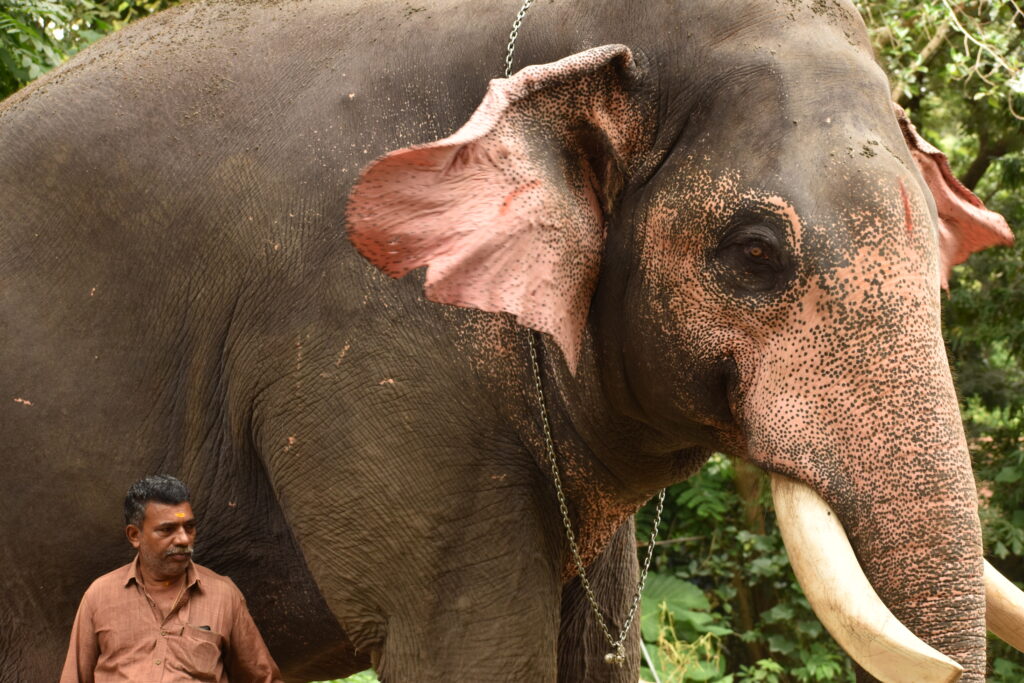
Today, captive elephants are more prone to health problems as they are frequently transported by lorry, made to stand for long hours, and receive inadequate rest due to the high demand for their presence at temple festivals. As a government veterinary officer explains, “Transporting elephants by lorry is never good for them. First, they do not get a chance to rest. Once a festival is over, they are loaded back onto the lorry and taken to another festival the next day. They have to balance and stand in the lorry, which prevents them from getting any sleep. An elephant is supposed to be taken for a procession only four days a week, but this guideline is often ignored. Also, it is recommended that elephants walk at least 20 km every day, but that has stopped since lorries came into the picture.”
Amid ongoing debates about elephant welfare, there is an urgent need to rethink what it truly means to care for these gentle giants. While modern veterinary science offers standardised protocols and diagnostic tools, it can sometimes overlook the depth of understanding that comes from years of close companionship, which is the kind of wisdom possessed by experienced mahouts. The future of elephant care lies not in favouring one system over another, but in creating synergy through a collaborative approach that combines ecological knowledge, scientific insight, and empirical observation. Such an approach will honour Kerala’s living heritage while adapting to the realities of a changing world.
Further Reading
Bist, S. S., G. Nair, J. V. Cheeran, K. Kutti Nayar and K. C. Panicker. 1997. Practical elephant management: A handbook for mahouts. Elephant Welfare Association.
Dubost J. M., E. Deharo, S. Palamy, C. Her, C. Phaekovilay, L. Vichith L, S. Duffillot et al. 2022. Interspecific medicinal knowledge and Mahout-Elephant interactions in Thongmyxay district, Laos. Revue d’ethnoécologie 22. https://doi.org/10.4000/ethnoecologie.9705.
Mazars, G. 1994. Traditional veterinary medicine in India. Revue Scientifique et Technique 13(2): 433-51.
